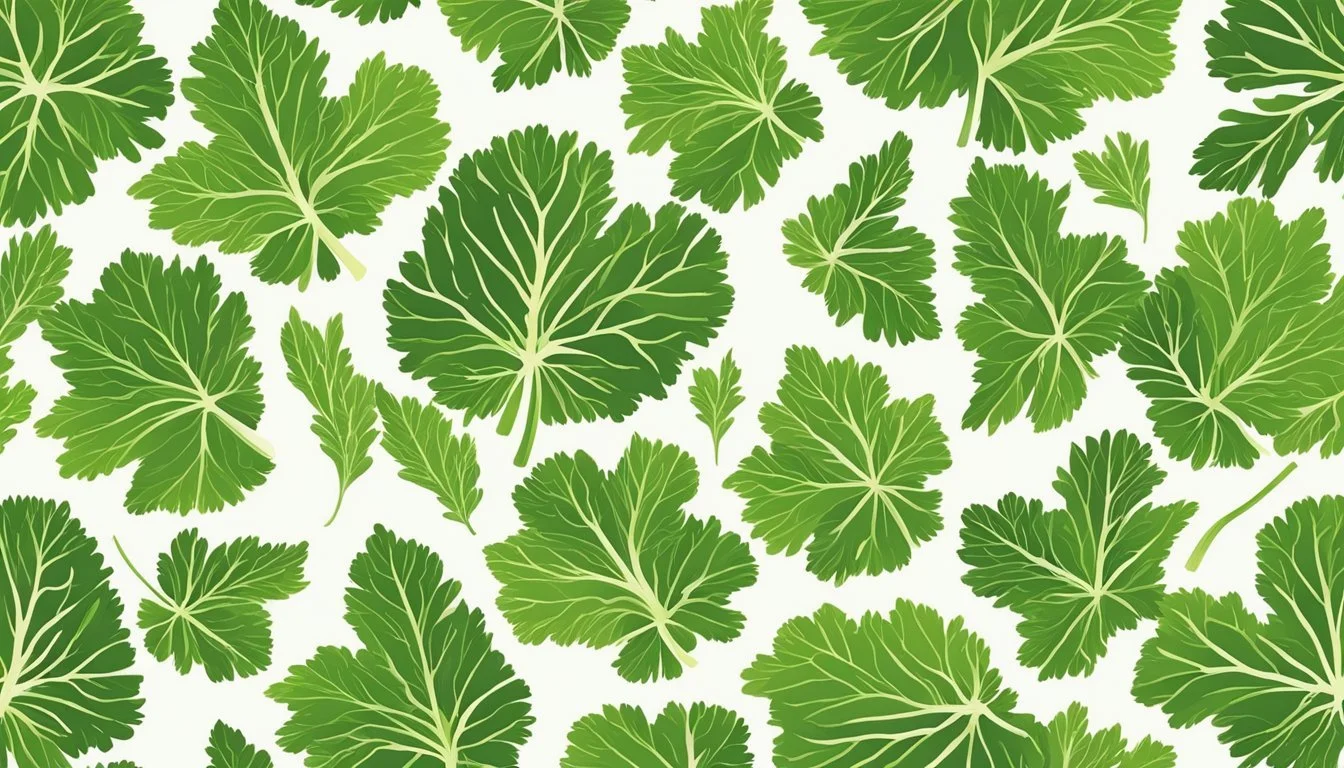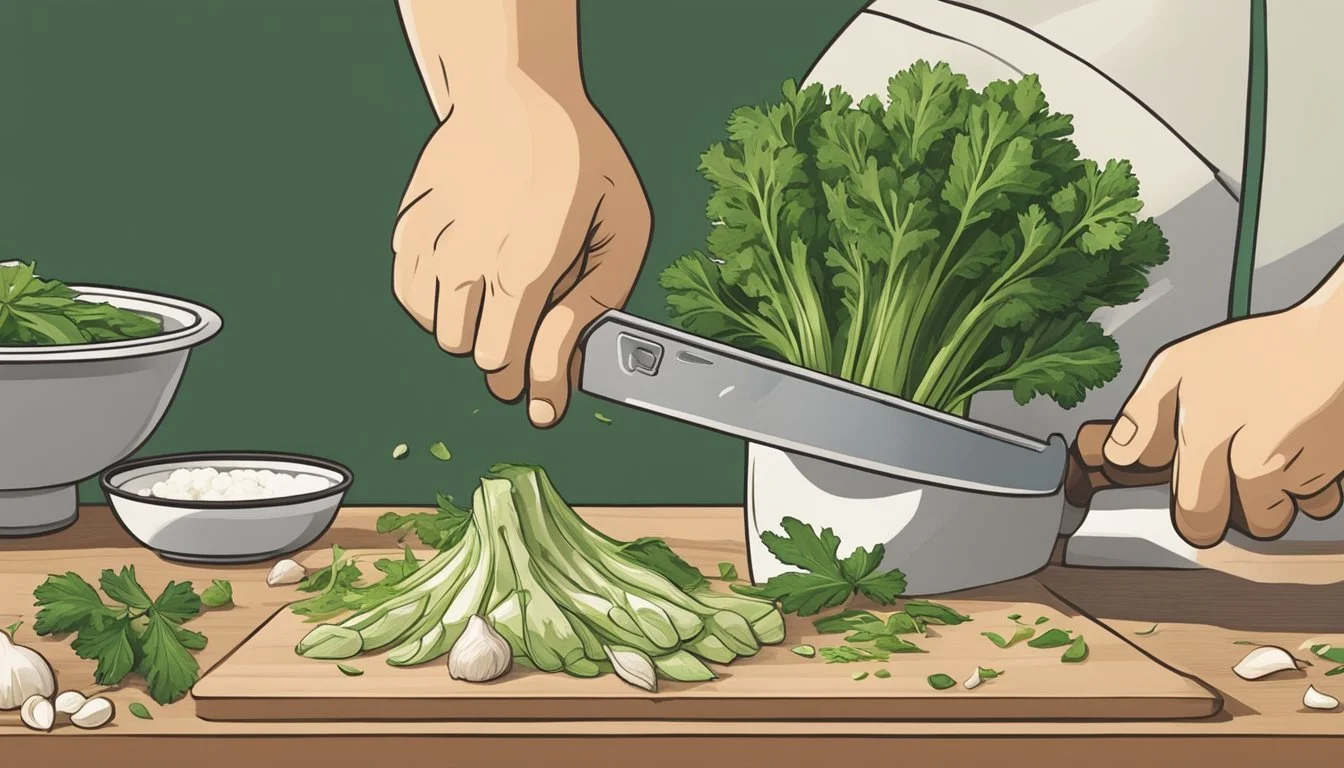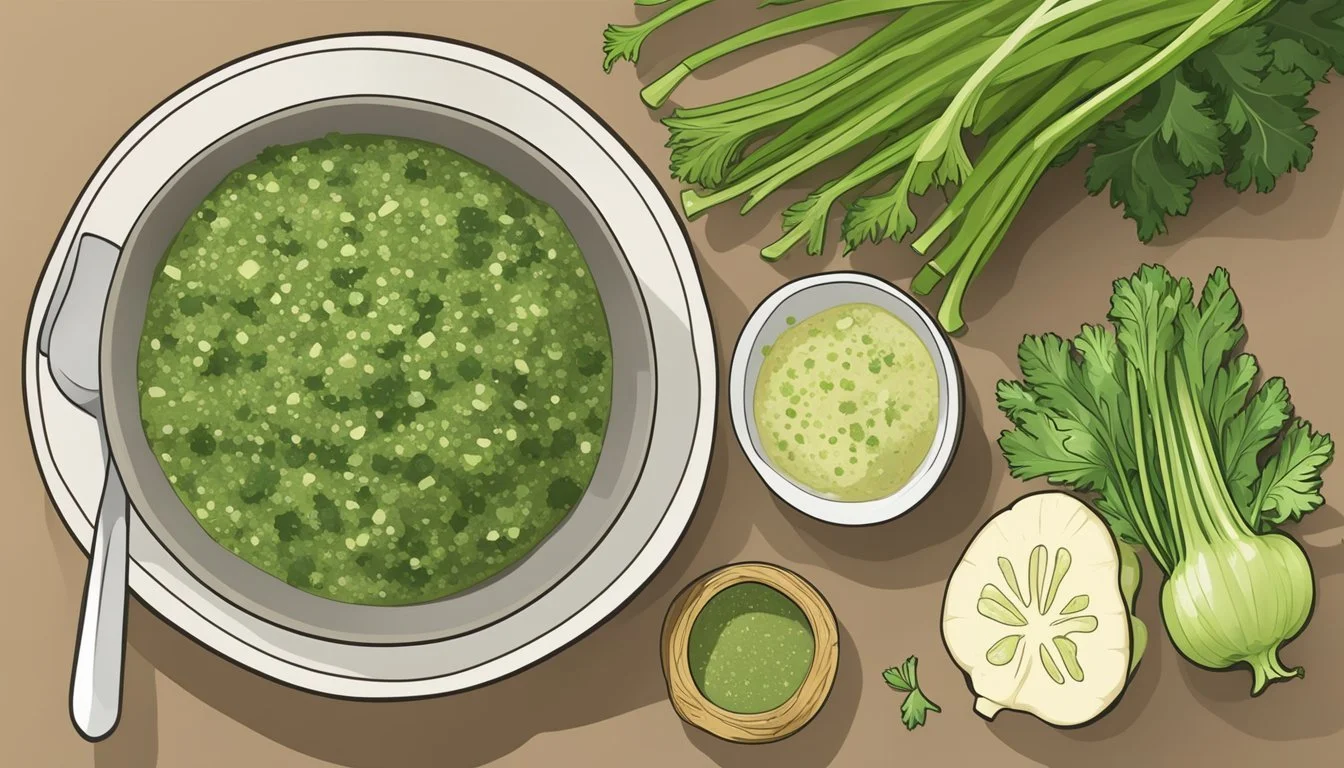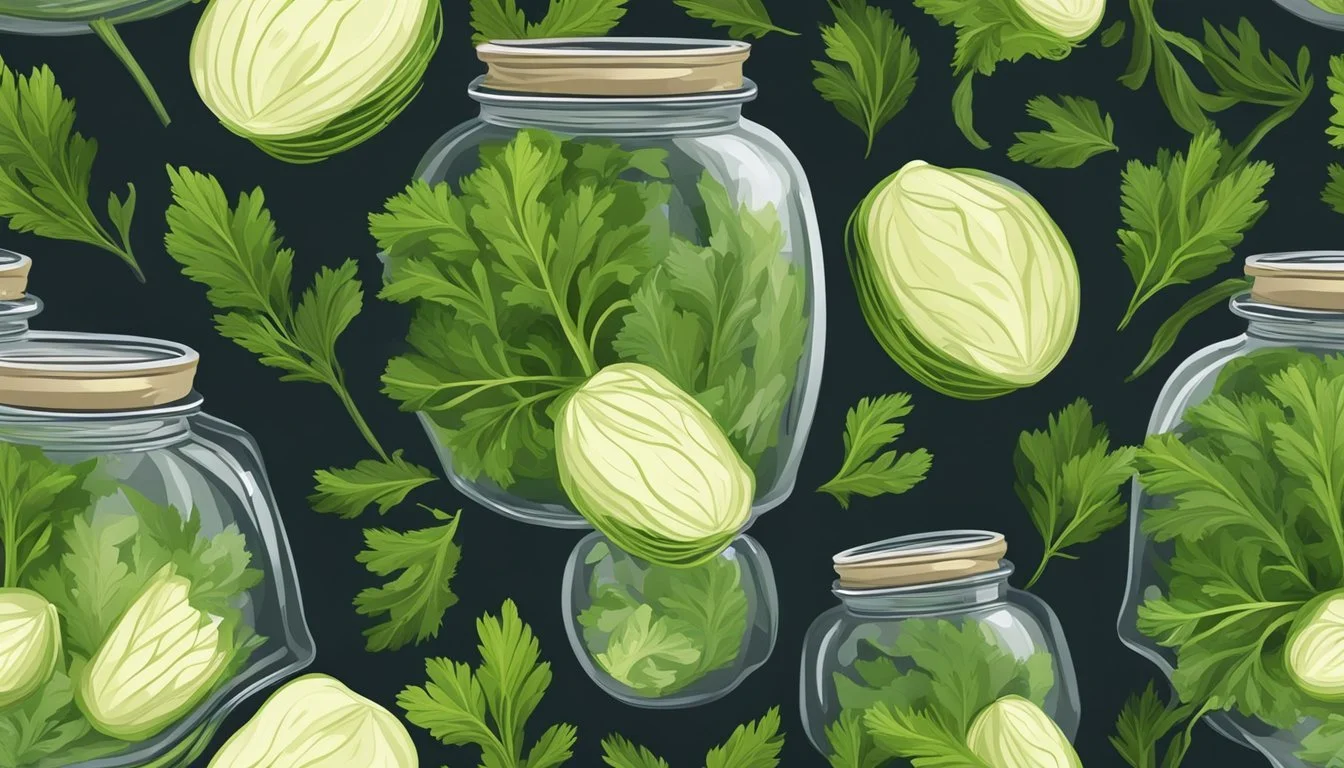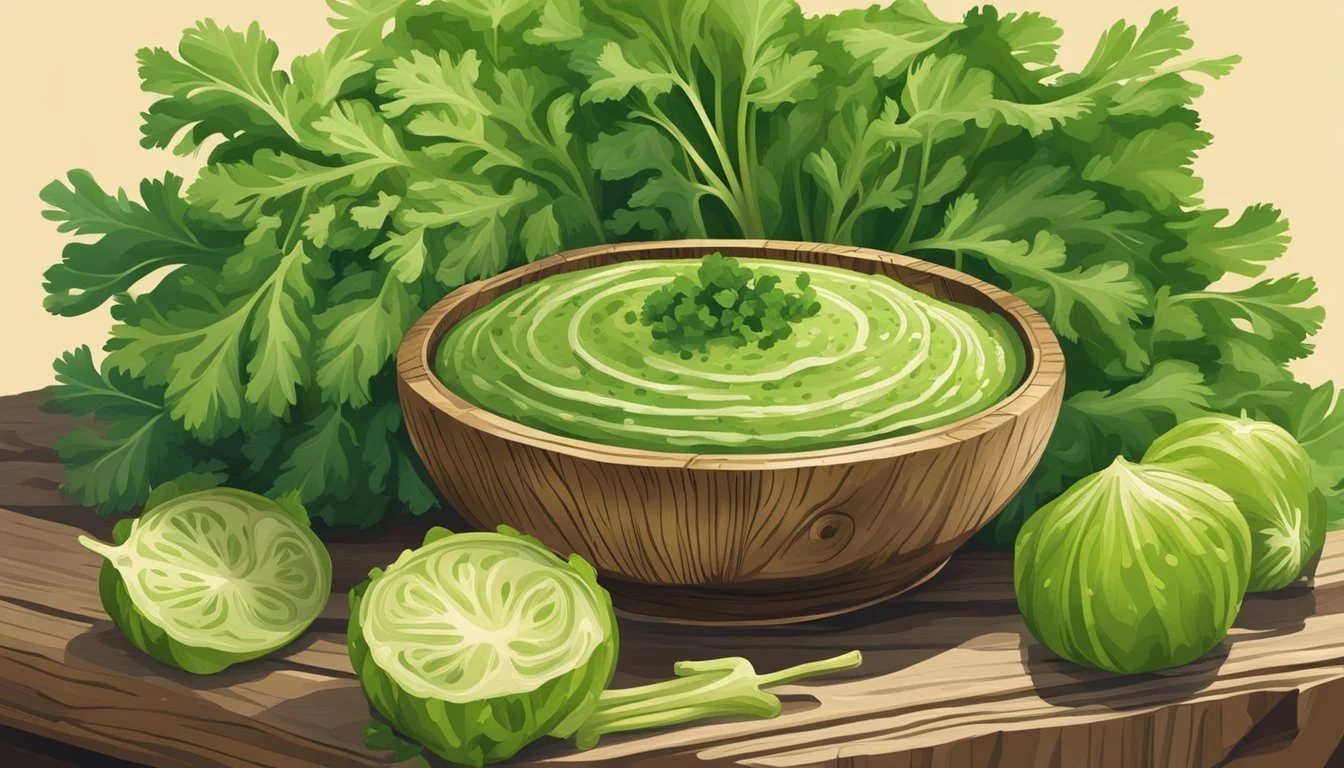Celery Root Leaf Salsa Verde
Elevating Dishes with Pungent Flavors and Aromatic Herbs
Celery root leaf salsa verde is a zesty twist on the traditional Italian green sauce that typically uses parsley as its base. This variation harnesses the often-discarded leaves of celery root, known for their strong, herbaceous flavor, to create a piquant and aromatic condiment. In addition to celery leaves, the sauce includes ingredients such as olive oil, garlic, capers, (What wine goes well with capers?) and sometimes anchovies (What wine goes well with anchovies?) or lemon juice, providing a complex, savory depth to dishes.
The adaptability of salsa verde allows it to be paired with a variety of foods, ranging from grilled meats (What wine goes well with grilled meats?) and vegetables to a spread for sandwiches. This sauce is particularly valued for its ability to enliven flavors, bringing both freshness and a punch of umami to the palate. It's a testament to the Italian culinary philosophy of using fresh, seasonal ingredients to create simple yet flavorful dishes.
In crafting celery root leaf salsa verde, one can choose to finely chop the ingredients for a rustic texture or blend them to achieve a smoother consistency. The balance of salty, tangy, and bitter notes can be adjusted according to personal taste, but it remains important to let the unique taste of celery leaves shine. This sauce can be prepared in advance, allowing its flavors to meld and develop over time, enhancing its appeal as an easy-to-make yet sophisticated addition to any meal.
Discovering Celery Root Leaf Salsa Verde
Exploring Celery Root Leaf Salsa Verde unveils a vibrant green sauce enriched with the robust flavor of celery leaves and Italian culinary traditions. This herbaceous condiment brings a refreshing twist to dishes with its combination of ingredients and historical roots, ideal for enhancing a wide range of meals.
Historical Background
Salsa verde, translating to 'green sauce,' has deep roots in Italian cuisine. Unlike its Mexican namesake that relies on tomatillos and cilantro, Italian salsa verde revolves around fresh herbs, olive oil, and other savory ingredients. The introduction of celery root leaves into this classic recipe reflects an innovation on the traditional blend, offering a unique and slightly bitter taste profile.
Culinary Uses
Celery Root Leaf Salsa Verde is celebrated for its versatility. It is often:
Drizzled over grilled or roasted meats (What wine goes well with roasted meats?), including chicken and steak
Used as a condiment for sandwiches and toast
Mixed into pasta or potato salads
Served alongside eggs, enhancing brunch options
Applied to baked or roasted vegetables (What wine goes well with roasted vegetables?) for added zest
Used to accent soups and salads with a piquant flavor note
Comparative Analysis
Celery Root Leaf Salsa Verde differs from both Italian Salsa Verde and Mexican Salsa Verde. The Italian version typically includes parsley, anchovies, capers, extra virgin olive oil, and lemon juice or vinegar. Celery root leaves contribute a fresh dimension, often replacing or complementing the parsley, to create a sauce that stands out with its distinct, earthy undertones.
Nutritional Insights
Given its incorporation of celery leaves and extra virgin olive oil, this salsa verde variant is low in calories and rich in nutritional value. It can be particularly appealing to those following a vegan diet. Additionally, as a fresh sauce, it avoids the preservatives found in many store-bought variants, thus offering a healthier alternative.
Food Pairings
Celery Root Leaf Salsa Verde acts as a piquant complement to various dishes, pairing exquisitely with:
Grilled meats like chops or steak
Roasted veggies, elevating their natural flavors
Grilled fish, where the sauce’s acidity complements the seafood’s richness
Simple carbohydrates like pasta and potatoes, adding an herbal kick
Whether used as a topping or a mix-in condiment, this green sauce variation brings a fresh perspective to traditional and contemporary recipes alike.
Analyzing Key Ingredients
The Celery Root Leaf Salsa Verde stands out for its bold, herbaceous quality, achieved by a careful blend of primary ingredients and optional flavor enhancers that allow for variations in taste.
Primary Ingredients Explained
Celery Leaves: The primary base of the salsa verde, celery leaves contribute a sharp and slightly bitter taste that is distinctive and aromatic.
Parsley: Often flat-leaf parsley is incorporated for its bright, clean flavor, enhancing the fresh herbaceous character of the sauce.
Garlic: Adds a pungent kick, which is crucial for the depth of flavor.
Olive Oil: Acts as a binding agent, lending a smooth texture and rich mouthfeel, while also balancing out sharpness.
Lemon Juice: Provides acidity, which brightens up the overall profile and cuts through the richness of the olive oil.
Anchovy Paste (optional): Offers a deep umami element; a little goes a long way.
Capers: Introduce a salty, briny quality that is characteristic of an authentic salsa verde.
Salt and Pepper: These seasonings are essential for elevating the other flavors and bringing the sauce into balance.
Flavour Enhancers and Variations
Flavor enhancers can be selectively used to tailor the salsa verde to personal tastes or to complement specific dishes.
Vinegar: Used in place of or alongside lemon juice, it contributes a different kind of tanginess.
Fresh Basil and Mint Leaves: Herbs like basil and mint can replace or join parsley, offering a sweeter or cooler flavor profile.
Red Pepper Flakes: For those who enjoy a spicy kick, adding a pinch can introduce a subtle heat.
Dijon Mustard: A teaspoon can add complexity and a mild sharpness, which pairs well with the other pungent ingredients.
Parmesan or Olives: (What wine goes well with olives?) Either can be added for an extra salty and savory dimension.
Gherkins or Pickles: Finely chopped, they can offer additional crunch and tang.
Lime Juice or Onion: Some variations introduce lime for a more citrus-forward flavor or onion for its sharp depth.
By mixing and matching these components, one can achieve a tailored salsa verde that complements a wide range of dishes, from grilled meats to roasted vegetables.
Salsa Verde Preparation Techniques
Salsa Verde, a vibrant and pungent sauce, is an amalgamation of fresh ingredients and culinary precision. Its preparation is rooted in classic techniques, with ample room for modern adaptations to enhance texture and consistency.
Classic Recipe Instructions
One begins the classic preparation of Salsa Verde by sourcing fresh ingredients: typically a combination of parsley, garlic, capers, and anchovies, with olive oil serving as the base. Prep time varies, but the process can be completed relatively quickly. To serve multiple guests, one might adjust the servings and proportionally increase the ingredients.
Step 1: Finely chop the celery leaves (or flat-leaf parsley), garlic, and capers. If using, mince the anchovies to a similar consistency.
Step 2: In a large bowl, combine the freshly chopped ingredients.
Step 3: Gradually add in olive oil until the mixture is well-blended but not overly saturated.
Step 4: Season with salt and pepper to taste.
For a visual guide, some may follow a video recipe that outlines the process step-by-step.
Alternative Methods and Tools
While a knife and board are traditional, modern kitchen tools can expedite preparation. An immersion blender, food processor, or standard blender offer varying degrees of texture control:
Immersion Blender: Ideal for a more rustic, textured sauce.
Food Processor: Provides a balance of texture and ease, leading to a finely chopped consistency.
Standard Blender/Mixer: Creates a smoother, more homogenous sauce.
Each tool requires monitoring to prevent the sauce from becoming too puréed. For those who appreciate artisan cooking, a mortar and pestle remains a viable option, imbuing the sauce with a more authentic feel.
Enhancing Texture and Consistency
Texture is paramount in Salsa Verde: too thick and it overwhelms delicate dishes, too thin and it lacks substance. For a thicker sauce, one might add breadcrumbs, ensuring they have been moistened to not detract from the sauce's moisture balance. Olive oil is often drizzled in slowly to achieve the desired consistency, allowing each addition to fully integrate before adding more.
To sum up, preparation techniques for Celery Root Leaf Salsa Verde vary widely, from time-honored to contemporary. The choice depends on individual preferences for texture and available kitchen tools, all while maintaining the fresh, herbaceous quality of the sauce.
Serving and Presentation
Celery Root Leaf Salsa Verde is a versatile sauce that enhances a range of dishes with its robust flavor. It can be served both as a condiment and as an appetizer with its foundation in fresh herbs like parsley and basil.
Appropriate Occasions for Serving
Celery Root Leaf Salsa Verde shines in settings that celebrate the rustic elegance of Italian cuisine. It can accompany grilled meats at a summer barbecue or serve as a dip in a more formal appetizer setting. The sauce's herbaceous nature also makes it a perfect complement to baked fish or poultry, suitable for both casual family dinners and more celebratory gatherings.
Recommendations for Garnishing
To garnish, one might consider the following accompaniments:
Lemon Zest: For a citrusy zing.
Fresh Parsley Sprigs: To reinforce the fresh herb notes.
Toasted Pine Nuts: For added texture and nuttiness.
These garnishes not only enliven the presentation but also enhance the overall taste profile of the dish.
Suggested Serving Temperatures
The pungency and herbaceous qualities of Celery Root Leaf Salsa Verde are best experienced at the following temperatures:
Room Temperature: Emphasizes the aromatic properties.
Slightly Chilled: Refreshing during warm weather events.
Serving the salsa verde at the right temperature ensures the full spectrum of flavors can be appreciated.
Plating Tips
When presenting Celery Root Leaf Salsa Verde:
Use a small bowl or ramekin for a neat and elegant presentation.
A drizzle of olive oil on top can add sheen and richness.
A side of crusty bread or crostini offers a textural contrast.
Clear presentation allows the vibrant green of the salsa verde to stand out, making it an alluring addition to the dining experience.
Storing and Preserving
When it comes to Salsa Verde made from celery root leaves, maintaining its freshness and vibrancy is paramount. This section will cover optimal strategies for short-term fridge storage, ways to prolong the sauce's life through freezing, and methods for rejuvenating leftovers.
Short-Term Storage Solutions
Refrigeration: For short-term storage, the sauce should be placed in an airtight glass or mason jar to minimize exposure to air. Store it in the coldest part of the fridge to slow down the degradation process.
Temperature: Keep the fridge temperature just above freezing to preserve the sauce's texture and flavor.
Container choice:
Seal in a glass jar with a tight lid.
Cover the surface with a layer of olive oil to create a seal against air.
Long-Term Preservation Methods
Freezing: For extending the shelf life, one can freeze the salsa verde. Using an ice cube tray is an excellent way to portion the sauce for later use.
Process:
Fill an ice cube tray with the salsa verde.
Once frozen, transfer to a freezer-safe bag or container.
Label with the date to keep track of freshness.
Container options:
Use a freezer-grade bag with as much air removed as possible.
Opt for durable containers that seal tightly to prevent freezer burn.
Duration:
Cellery root leaf salsa verde can typically last up to 3 months in the freezer while retaining its quality.
Revitalizing Leftover Salsa Verde
Refreshing Techniques: If the salsa verde appears to lose some of its bold flavors after storage, there are ways to bring back its zest.
Acid addition: A small squeeze of fresh lemon juice can brighten the flavors.
Stirring: Ensuring to stir the salsa after storage distributes the oils and flavors more evenly.
Frequently Asked Questions (FAQs)
This section provides answers to common queries regarding the preparation, preservation, and serving of Celery Root Leaf Salsa Verde.
Common Preparation Queries
Celery Root Leaf Salsa Verde is typically quick to prepare, with a prep time that varies based on technique but can take as little as 15 minutes. The ingredients often include celery root leaves, capers, anchovy paste, garlic, olive oil, and seasonings to taste. These components are blended until they reach a consistent texture. The resulting sauce should resemble a paste that's spreadable yet thick enough to cling onto foods it accompanies.
Addressing Preservation Concerns
Storing the salsa verde properly is crucial for maintaining freshness. It should be stored in a mason jar or an airtight container in the refrigerator. When sealed correctly, it can last up to 5-7 days. As for freezing, the sauce can be frozen in an airtight container for up to one month. However, one should be mindful that while freezing can extend the shelf-life, it may slightly alter the texture or flavor once thawed.
Clarifying Serving Suggestions
Celery Root Leaf Salsa Verde functions both as a dip and a spread for various dishes. It pairs well with grilled meats, fish, and even as an accompaniment to roasted vegetables. One may also spread it on sandwiches or use it as a vibrant dressing for salads. The sauce's piquant flavor is versatile enough to enhance a wide range of dishes.
Conclusion
Celery leaf salsa verde introduces a fresh twist to traditional Italian salsa verde with its inclusion of celery leaves. This distinctive choice imbues the sauce with a vibrant and somewhat bitter undertone that complements the pungency of garlic, tanginess of capers, and umami from anchovies. Celery leaves are not commonplace in many kitchens; however, their use in this salsa verde underscores their potential to elevate a simple condiment into a noteworthy accompaniment.
The versatility of this sauce is noteworthy. It serves as a dynamic partner to an array of dishes, from grilled meats to roasted vegetables, and can even add depth to sandwiches and salads. One can adjust the intensity of flavor by adding more or less of the key ingredients, tailoring the sauce to personal preference.
In crafting celery leaf salsa verde, chefs recommend a balance of ingredients:
Garlic and anchovies for depth
Capers for a burst of acidity
Olive oil as the emulsifying base
Lemon juice or vinegar for a sharp, bright note
Celery leaf salsa verde holds its own as a sustainable choice by making use of an often-discarded part of the celery. It is a stellar example of how one can reduce waste and, simultaneously, discover new flavor profiles.
Its preparation is straightforward, requiring no specialized equipment, which makes it accessible to cooks at all levels. A simple chopping board and knife or a basic food processor are all that is needed to achieve a homogenous blend. This ease of preparation, alongside its robust flavor and versatility, firmly establishes celery leaf salsa verde as a valued addition to the culinary repertoire.


